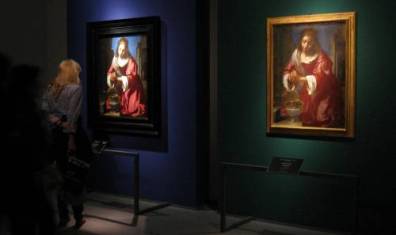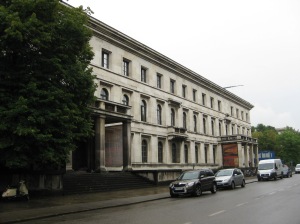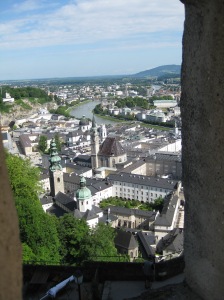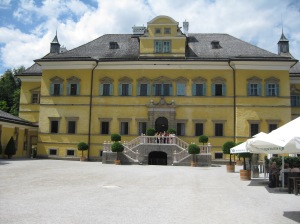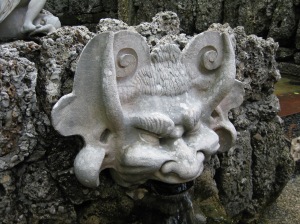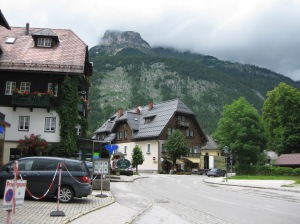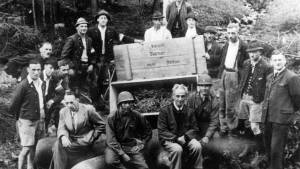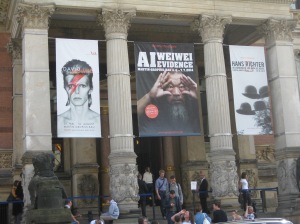I take a bus tour from Munich to see two of most famous castles in the world, the product of King Ludwig II. I share the giant two-story bus with both Canadians and American tourists. Together we leave Munich and drive towards to the Alps where King Ludwig II played, planning and building a series of fantasy luxury estates. The passing villages are all clean and orderly with large chalet farm houses, their railings lined with geraniums and yards filled with cords of wood stacked in obsessive piles.

Our first stop is Linderhof Palace, a mini Versailles Ludwig dreamed up high in a far valley. It must have irked the poor government officers as they made the strenuous two-day journey from Munich to the king’s residence where the royal recluse played king. Ludwig spent a goodly number of years fantasizing his regal world, but never had visitors other than the government bureaucrats who came to pester him.
Our tourguide gives us our marching orders and then drops us off. She is friendly, but the syntax of her directions are vague which keeps us, the tour group relying on each other to figure out what she meant. A tall Linden tree dominates the estate on a terraced vista, inspiring the name of the place. Being a fan of the French absolute ruler Louis XIV, Ludwig created an embarrassment of riches. The palace itself is relatively small, but expresses the ultimate classical symmetry. There is too much gilded ornament to take in, each room representing an obsessive attention to outdated ceremony. Outside the surrounding gardens are filled with the requisite grottos, pools, stairs and mythological statues which includes lots of big-bottomed women.

We are hustled through the palace, most of us hurrying back as soon as the tour finishes since we are worried about being left behind. We load up and then the big bus bumps along the narrow road to a mountain pass. The land is high and the winter snows must be deep. We arrive at a small village which has a typically descriptive German name – Oberammergau which means a town spanning the Ammer creek in the upper area of Bayern. It has the traditional German village markers – the May Pole, wall frescoes, lots of Catholic churches and pretty chalets. This village’s main industries are surprising, involving both wood carving and passion plays. Over half of the residences are wood carvers while once a decade the entire community presents a full live passion play complete with farm animals. This tradition stems from the 17th century when the village made this vow in thanks for being spared from the plague. This Christian production runs for months and attracts audiences internationally. Certainly a unique business plan.

We stop in a gift shop which is lined with cuckoo clocks and gridlocked with tourists. Soon we are back on the bus and driving towards a high plain surrounded by mountains. I see lots of bicyclists and wish I could do a riding trip here. The land is dramatic with green fields and mountains which are disturbingly bare for this time of year. Climate change has made its mark here. We pass a beautiful lake that has purposely been left undeveloped by the locals to maintain the wildness. An astounding feat in this commercial age.
Finally we turn a corner and see the tall white palace of Neuschwanstein looming up on a high hill beside a mountain range.

Neuschwanstein’s name was derived from the Schwanstein castle ruins that once stood on the same site. Ludwig started designing his dream castle here in 1868, contracting an architect and stage designer to realize his Wagner-inspired residence. Amazing what one can do with imagination, lots of money and a touch of insanity. Over the next 20 years, his building frenzy emptied the coffers and drove his ministers to declare him insane and to lock him up which lead to his mysterious death in 1886. Ironically, his spending spree paid off since only weeks after his death, the government opened up both of his houses to the public, creating one of the first destination tourist attractions. With 13 years it had paid itself off, and since then became one of the primary income sources in Bavarian. Today, Neuschwanstein is the most visited places in Europe with over 1.3 million visitors per year. No wonder Walt Disney copied it.
Neuschwanstein has more significance for me than a Euro-Disneyesque attraction. It has a connection to Vermeer reaching back to the Second World War. Part of Hitler’s megalomaniacal plans for the world involved culture, so as soon as he began to invade other countries, he began collecting masterpieces. Some of his largest plunder came from France where he emptied the coffers of country’s wealthy Jewish families. Hitler’s henchmen plucked the Vermeer painting the Astronomer from the wall of the Rothschild’s Paris apartment. This work, along with thousands of others, ended up at the Jeu de Palme Museum where it was carefully catalogued before being sent away to the Fatherland to become part of the Fuhrer’s collection for a future world museum in Linz. As the war turned against Hitler, these art works were secreted into the Austrian mountains for safekeeping. The records, however, were sent to Neuschwanstein. As the Monuments Men from the US Army tracked down the art trail, they discovered this precious cache of records that would be essential in tracing the looted art works back to their original owners.
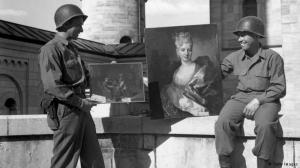
Our tour bus winds up some narrow roads towards a group of buildings which becomes obvious is Schwan-central. After a century of tourism, a full industry has flourished here. The place is congested and noisy with tourists and buses. Our guide gives us some confusing orders and we all gather to translate. What did she mean by the meeting time? Two-twenty, two and two zero, twenty-twenty two? We stop for lunch but don’t dare stray too far from the bus which is our meeting place for the shuttle which will take us up to the castle ridge. A van pulls up and a burly man gets out, crams us inside and then demands money for the ride. Thus comes the hidden extra costs. Once up top, we clutch our tickets and wander around, happy to have a written-down hour for our appointment. I walk down to a high bridge that overlooks the castle. It’s a beautiful view, but jammed with people.

The mixture of heights and crowds too much for me. I manage only a few minutes before I retreat and chat with a Hurdy Gurdy player who entertains the passing crowds with songs and tunes.
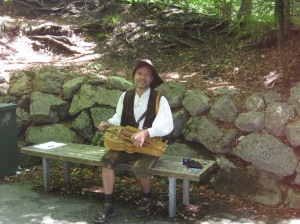
The young soft-spoken man is wearing a brown felt hat with a large wilting brim. Turns out he is a historian who was laid off from a local museum – tough all around. Apparently his position here is now in jeopardy as well. I wish him luck and make my way down to the castle where I meet my colleagues and we take bets as to how many of our tour will get lost.
German precision has us meet at a specific time. Soon we are crammed into a group inside where we are informed that no photo taking. Part of the growing copyright trend I see in more museums these days. The tour is quick and we are pushed through each room to keep the crush of people going. It’s hard to describe the unfinished folly since like Linderhof, there is too much detailing to take in. Ludwig went for a pastiche of styles from Byzantine to Gothic and Romanesque, all steeped with a Romantic fairy tale mood depicted in painted murals everywhere. Ludwig eschewed electricity in his fantasy home, but ironically included one of the first telephones and water closets (both carefully hidden). As I walk about, I imagine the rooms and hallways filled not only with gilded furniture, but filing cabinets containing the records of all the art looted from France’s Jewish families. The fantasy palace held some dark secrets. Strangely enough, the tour guide makes no mention of this.
The goofiest element included in the palace in the new grotto he included in one hallway which one stumbles upon when rounding a corner – like a film set. Tacky begins to come to mind and it’s all a bit sad when you think about the disconnect life it represented. Despite all that, Ludwig got it right with the vistas which overlook the Alps and that beautiful lake now dotted with sailboats. The day is clear and we all enjoy the breeze from the narrow balcony despite jostling each other for photos.
 We finish the tour in the music hall, one that never saw an audience since Ludwig was too shy. Concerts are held here now regularly to take advantage of the good acoustics. I notice a woman carefully dusting one of the ornate chairs lining the hall. It looks dreary and time consuming work. The place is a duster’s nightmare since Ludwig’s bedroom has a bed canopy with a forest of Gothic carved – wooden spires that took 40 wood carvers four years to create. At least Ludwig paid all his workers well, according to historical reports (unlike many other aristocrats). There isn’t time to relax since we must make our way down the hill back to Schwanville.
We finish the tour in the music hall, one that never saw an audience since Ludwig was too shy. Concerts are held here now regularly to take advantage of the good acoustics. I notice a woman carefully dusting one of the ornate chairs lining the hall. It looks dreary and time consuming work. The place is a duster’s nightmare since Ludwig’s bedroom has a bed canopy with a forest of Gothic carved – wooden spires that took 40 wood carvers four years to create. At least Ludwig paid all his workers well, according to historical reports (unlike many other aristocrats). There isn’t time to relax since we must make our way down the hill back to Schwanville.
 We meet at the bottom back with the convoy of buses and wait in the hot sunshine. To our surprise, no one goes missing. Once loaded up, the bus takes us back to Munich, passing solar power farms, a new crop in Germany which accounts for over half the power generation here.
We meet at the bottom back with the convoy of buses and wait in the hot sunshine. To our surprise, no one goes missing. Once loaded up, the bus takes us back to Munich, passing solar power farms, a new crop in Germany which accounts for over half the power generation here.



